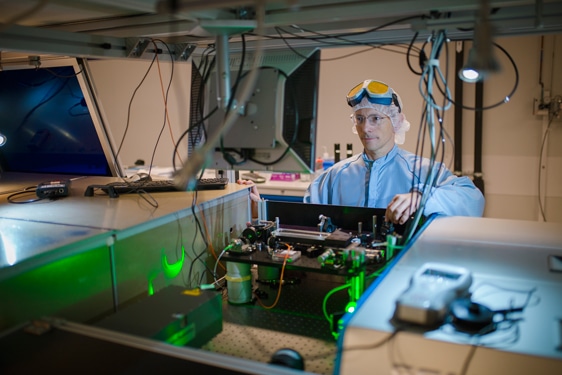Sep 28 2016
An enthusiastic László Veisz shows his laser lab in the basement of the Natural Sciences Building at Umeå University. His research on ultrafast processes is now reaching the incredible time scale that describes electron movements in atoms, molecules and ionised plasma.
 The system belongs to the highest class in laser safety. Goggles are necessary – if the laser beam gets into your eye you can easily go blind. Air shower, the hair net, coat and overshoes are needed to avoid dust in the laser room. Dust goes onto optics and deteriorates laser performance and even can lead to damages to the laser and mirrors. Credit: Mattias Pettersson, Umeå University.
The system belongs to the highest class in laser safety. Goggles are necessary – if the laser beam gets into your eye you can easily go blind. Air shower, the hair net, coat and overshoes are needed to avoid dust in the laser room. Dust goes onto optics and deteriorates laser performance and even can lead to damages to the laser and mirrors. Credit: Mattias Pettersson, Umeå University.
“Using advanced laser technology, we can both record and affect electron dynamics with an unparalleled time resolution and precision,” he says.
László Veisz is since March this year new professor in Physics at Umeå University. His previously most recent assignment was at the Max Planck Institute of Quantum Optics outside of Munich in Germany.
One of the greatest challenges of moving to Umeå has been to move the laser laboratory itself. László Veisz’ research team are highly picky in their requirements of premises. The equipment requires a length of between 13 and 26 metres in order to conduct experiments optimally.
“Two huge lorries were needed to move the equipment, which included lasers, optics and vacuum chambers,” says László Veisz.
László Veisz and his team of researchers have to a large extent developed and set up the laser facility themselves. After four months of hard work, most of the equipment is now in place in a basement on Campus Umeå. The facility might look unpretentious at a glance, but in actual fact, it is world-leading and few other research teams internationally have the same prerequisites and technical capacity.
“The initial tests in the new premises have shown very promising results. Disturbances from the outside are small in the basement, which is promising for future research.”
The laser system delivers short, very intense flashes of light that in turn generate even shorter pulse signals of extreme ultraviolet light or electrons all through complicated interaction processes of matter.
“The pulses are only about 100 attoseconds long (= 10-16 s). It’s actually the shortest light and electron pulses ever created!
Using these short light and electron pulses enables studies on new time resolution levels that can provide unique information on matter, and control reactions within matter. This in turn is expected to advance the pioneering research in areas such as Optoelectronics and structure determination in Biomedicine, predicts László Veisz.
“I think the future holds more opportunities to commercialise some of our technology. The market for such specialised laser optics is of course very small, but the number of research teams who are interested in Quantum Optics have increased in recent years – especially in China.”